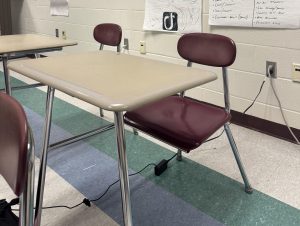The unbearable heat
“It’s very difficult to concentrate when it’s hot and humid,” said Mary Martin 20’. HB students, especially those on the third floor, are victim to the intense heat in classrooms and hallways. By staying hydrated and wearing light layers, students attempt to survive the heat.
May 8, 2018
It is May 1, 80 degrees outside, and you’re stuck on the third floor with sweat dripping down your face while you try to copy down the most challenging math notes of your education thus far. There are still twenty more days of school, during which you have to tolerate a smoldering hot classroom. Why should students have to be dripping sweat in school during the summer, when air conditioning is a simple solution?
Studies have shown that students tend to be more focused when they are in a comfortable environment, which, of course, includes the temperature of their learning space. Although it may not seem like a student’s environment can affect them, it impacts 25% of the learning process by making the students less attentive. When a student is sitting in a classroom, hot and sweaty, their body focuses on cooling down rather than on schoolwork. A study on why air conditioning in essential in schools has shown that higher temperatures cause a 12.3% chance of failing a class and a 2.5% lower chance of graduating on time.
In many states, like Florida and Texas, it is mandatory to provide air conditioning in schools. The average temperature in Florida during the month of May is about 88 degrees, which means AC is a necessity. In New England, the average temperature in June is up to about 80 degrees, sometimes even hotter. Why should students have to deal with the heat in schools when it can get to the same temperatures here as the hottest state in the US? Although New England’s summers are not nearly as long as those in the south, we should still have the access to turn on the air conditioning when necessary to survive the heat.
Why should the school install AC? Although it is sometimes hard to understand why a school in New England should have air conditioning, varying temperatures throughout the year have a big effect on students.
Principal Richard Barnes has a strong opinion that air conditioning is not needed at HBHS. “AC is much too expensive to run building-wide for the short duration we need it,” said Barnes. However, going from harsh New England winters that sometimes starts at the end of April to 80-degree days in June with the sun constantly smoldering overhead is tough for many students.
The best way to provide AC at Hollis Brookline High School is to implement individual AC units. Each unit would cost about $3,000 to $4,000, and would be installed through the roof tops and provide AC for each floor.
Installing the units is a difficult task. Ultimately, the air conditioning should have been positioned when the building was originally built, though it is still a possibility. “When we replaced the 2 ACs in room 217 [a computer lab], it cost 10 grand, because it has to have rooftop units,” said John Gray, a custodian at HBHS.
Students are not the only ones that must suffer through this environment. Classrooms can get very hot quickly, which tends to make staff lose focus as well. “The school should have AC because students need to be in a comfortable environment to perform well. Having a temperature environment enables students to focus on their studies,” said Mary Martin ‘20. As you climb up the stairs and get closer to the third floor, you can feel the temperature rise. This means that on hot days, it is difficult for students and teachers to perform at their best.
Next time students are sitting in a room at the end of the school year, while the temperature starts to rise, and they are trying to focus on the lesson, think about how it would be different if the room was air-conditioned. Why should students have to think about warm and suffocating air coming through the window, instead of the cold and refreshing air that could be coming through the vents?














